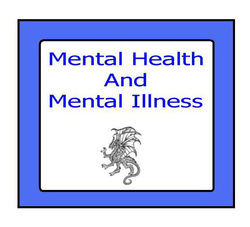
There is one more vital area to cover before we begin to look at the specific illnesses that are the subject of this series and in fairness, will require two parts. We have to ask how is mental illness diagnosed and who is qualified to make this critical evaluation? The answers to these questions are a bit complicated based on my experience and close examination of the mental health system. And, while it may seem fairly straightforward, there are aspects of the diagnostic protocol that need reform.
First, let's consider the fact that all structured investigations have guidelines for determination of whatever facts are needed. Metal illness is no exception, and this structure comes from the American Psychiatric Association. They publish the DSM, (Diagnostic and Statistical Manual of Mental Disorders). The current edition is the DSM-IV-TR, which is a text revision. There is a new version due in 2013 from my understanding. This is the guideline manual that covers all recognized mental illnesses and the criteria needed for evaluation. All mental health professionals use this manual in the US, and it is the basis for all diagnostics in mental illness.
The DSM uses a mufti-axis model to allow the health professional to qualify and semi-quantify a particular illness. It is a five axis system and although it seems complicated, it is a workable system. I will cover the axis's briefly here, but there will be more as we look at mental illness more deeply. Axis I is the clinical syndromes or what we might call the primary diagnosis. Example might be depression, schizophrenia, bipolar, etc. Axis II are the developmental and personality disorders. The developmental disorders are those typically discovered in childhood as autism and mental retardation. The personality disorders may be collective syndromes as paranoid, antisocial, or borderline personality. Axis III looks at the physical condition of the patient and might consider brain injury or other physical condition that may impact symptoms of mental illness. Axis IV in the severity of psychosocial stressors such as death of a loved one, divorce, or job loss. Axis V is a global assessment of functioning and that considers at what level the patient is now functioning, and the highest level in the previous year.
Hopefully, in this post entry, there is some understanding of how mental illness is diagnosed and the strategies that have been useful in designing treatment and general prognosis protocols. In part 5, we will consider how this system really works and what can go wrong with the use of the guidelines discussed.
First, let's consider the fact that all structured investigations have guidelines for determination of whatever facts are needed. Metal illness is no exception, and this structure comes from the American Psychiatric Association. They publish the DSM, (Diagnostic and Statistical Manual of Mental Disorders). The current edition is the DSM-IV-TR, which is a text revision. There is a new version due in 2013 from my understanding. This is the guideline manual that covers all recognized mental illnesses and the criteria needed for evaluation. All mental health professionals use this manual in the US, and it is the basis for all diagnostics in mental illness.
The DSM uses a mufti-axis model to allow the health professional to qualify and semi-quantify a particular illness. It is a five axis system and although it seems complicated, it is a workable system. I will cover the axis's briefly here, but there will be more as we look at mental illness more deeply. Axis I is the clinical syndromes or what we might call the primary diagnosis. Example might be depression, schizophrenia, bipolar, etc. Axis II are the developmental and personality disorders. The developmental disorders are those typically discovered in childhood as autism and mental retardation. The personality disorders may be collective syndromes as paranoid, antisocial, or borderline personality. Axis III looks at the physical condition of the patient and might consider brain injury or other physical condition that may impact symptoms of mental illness. Axis IV in the severity of psychosocial stressors such as death of a loved one, divorce, or job loss. Axis V is a global assessment of functioning and that considers at what level the patient is now functioning, and the highest level in the previous year.
Hopefully, in this post entry, there is some understanding of how mental illness is diagnosed and the strategies that have been useful in designing treatment and general prognosis protocols. In part 5, we will consider how this system really works and what can go wrong with the use of the guidelines discussed.
 RSS Feed
RSS Feed
